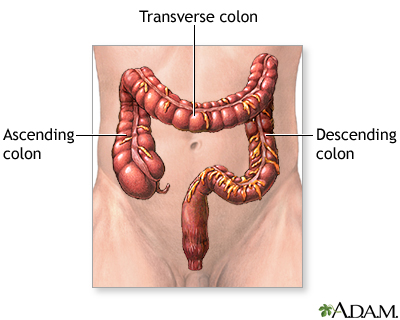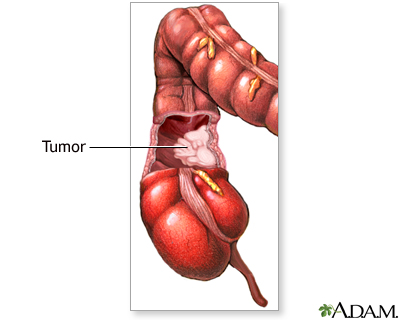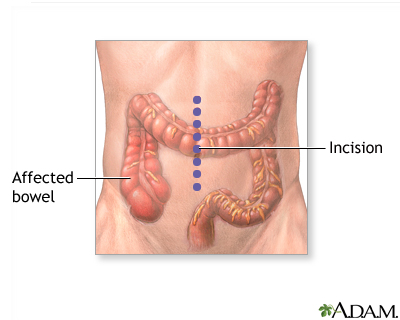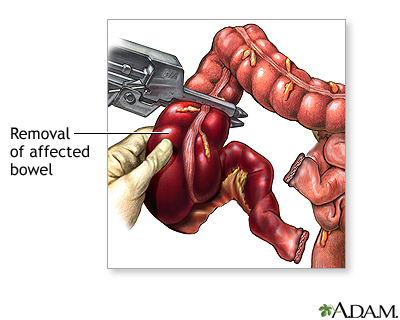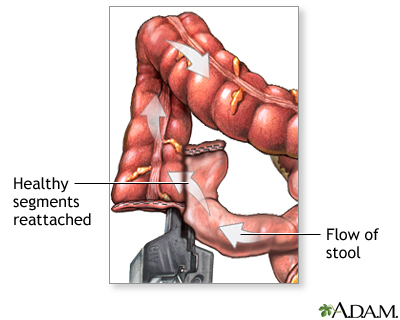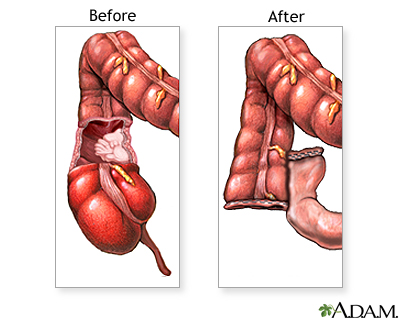Large bowel resection
| Normal anatomy |
|
The large bowel [the large intestine, or colon] is part of the digestive system. It runs from the small intestine to the rectum. It is made up of three portions; the ascending, transverse and descending colon. The ascending colon is sometimes referred to as the right colon; the descending colon is sometimes referred to as the left, or sigmoid colon. |
| Indications |
Bowel resection may be indicated for:
- blockage of the intestine (intestinal obstruction) due to scar tissue or tumors
- bleeding, due to diverticulosis or arteriovenous malformations
- injuries
- cancer
- precancerous polyps
- familial polyposis
- infection, due to diverticulitis
|
| Incision |
|
The patient is deep asleep and pain-free (general anesthesia). A lower midline incision is made in the abdomen. Sometimes, the surgeon will use a lateral lower transverse incision instead. Laparoscopic bowel resection is sometimes possible. |
| Procedure, part 1 |
| The diseased part of the large intestine (colon) is removed. The two healthy ends are then sewn or stapled back together and the incision is closed. A stapling procedure is shown here.
|
| Procedure, part 2 |
| If it is necessary to spare the intestine from its normal digestive work while it heals, a temporary opening of the intestine onto the abdomen (colostomy) may be done. A temporary colostomy will be closed and repaired later. If a large portion of the bowel is removed, the colostomy may be permanent.
The large intestine (colon) absorbs most of the fluid from foods. When the colon is bypassed by a colostomy in the right colon, the colostomy output is generally liquid stool (feces). If the colon is bypassed in the left colon, the colostomy output is generally more solid stool. The constant or frequent drainage of liquid stool can cause the skin around the colostomy to become inflamed. Careful skin care and a well-fitting colostomy bag can reduce this irritation.
|
| Aftercare |
| Most patients will stay in the hospital for 5 to 7 days. Complete recovery from surgery may take 2 months. During the first few days after surgery, eating is restricted.
|

|
Review Date:
5/21/2012
Reviewed By:
Harvey Simon, MD, Editor-in-Chief, Associate Professor of Medicine, Harvard Medical School; Physician, Massachusetts General Hospital. |
The information provided herein should not be used during any medical emergency or for the diagnosis or treatment of any medical condition. A licensed medical professional should be consulted for diagnosis and treatment of any and all medical conditions. Links to other sites are provided for information only -- they do not constitute endorsements of those other sites. © 1997-
A.D.A.M., Inc. Any duplication or distribution of the information contained herein is strictly prohibited.



